Journal Entry
Entry Date: May 17, 2000
I have just returned to Tucson, Arizona, after living in Boulder, Colorado for
eight months, and found some photos of some of my earliest adventures in
the Arizona area between January and July 1999. Hope you enjoy them! ---Kim
First of all, the landscape around Arizona is very different from anything
I have ever experienced. Here I show some samples of the variety of cacti
in the Sonoran desert. This desert terrain is typical of southern Arizona
and SW New Mexico, and NW Mexico, and is much different from desert terrain
in Utah, with which I had been more acquainted. It is named after the county
Sonora in Mexico which borders the southern side of the state of Arizona.
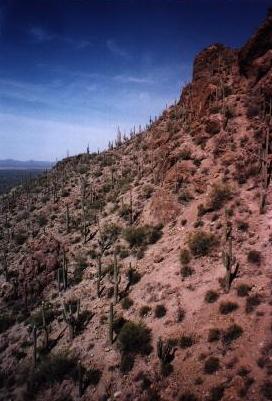
The 'king of the Sonoran desert,' the saguaro cacti.
These cacti are only found in the Sonoran desert. They are slow
growers and might spurt an arm after 70-80 years of living. The more arms you
see on the saguaro, the more ancient it is.

Barrel cacti in Tucson, AZ.
They come in a variety of shapes and sizes. Most
common in town is the fishhook barrel where the thorns look like fish-hooks.
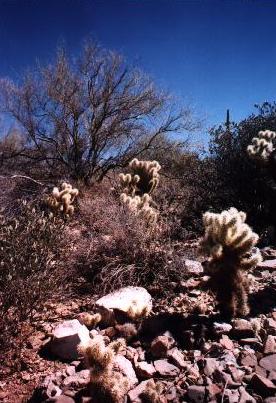
A sample of a cholla (pronounced: choy-ya) cacti.
This one is called 'teddy-bear cholla.' Do you want to hug this teddy?

A yucca plant.
The yucca, very important to the indigenous people of the southwest for
material for baskets, footwear, roofing, etc., is not a cactus, but rather
a xenophyte. It lacks the thorns that cacti have. This distinction also
applies to the agave plants. Here this yucca is in a treelike setting, whereas
most yuccas in the desert are ground bushlike.
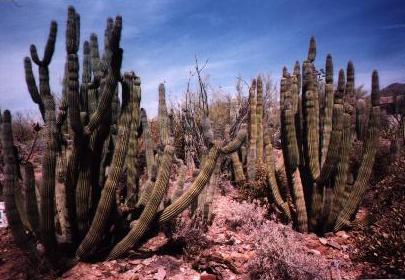
Organ pipe cacti.
This cactus, which I tend to confuse with young (less than 50 years) saguaro.
When plentiful as in this picture, they share a common base and grow out like
organ pipes, and hence the name. When they are alone in the wild, you look
for the narrow trunk.
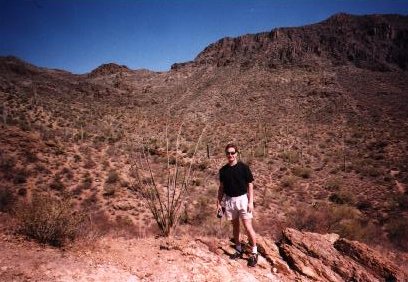
My brother visited in February 1999 and here he is next to an ocotillo.
These 'dead-like' stick cactic sprout green leaves immediately upon any water
fall and bloom red at the tips of the sticks. Once the weather gets dry again,
they turn back into being 'dead-like' only to surprise you when moisture
returns.
I did some travelling in northern Arizona in February 1999, when Doug's mom
came to visit. We travelled to the petrified forest, took a glimpse of the
Grand Canyon, visited the Sunset Crater, a volcanic depression near the
San Franciso peaks, and saw some ruins at Wupatki national monument.

The painted desert area near Flagstaff.
It got its names due to the colors of the sand.

Image of a small desert dust devil.
The desert is a place for interesting thermals, which carry dust and also
birds into twisting motions.

The Grand Canyon.
I was only at the rim for one afternoon to take this shot. Someday I will
return for a more investigative tour. It was very wide -- over a mile across,
which sadly might not be captured in my photo.

The San Francisco Peaks.
Arizona does have mountains...these are volcanic in origin.

Sunset crater.
A volcanic depression which was named after its colour (red), that of sunset.
The area around it was also very interesting with lots of lava fields,
reminiscent of Hawaii.
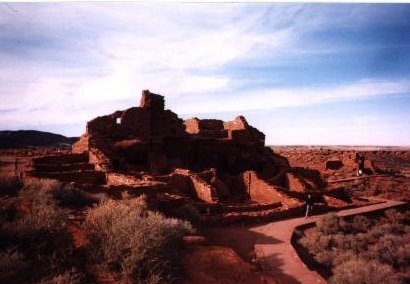
A view of the main ruin a Wupatki natioanl monument. More
views of the ancient Pueblo (previously, but erroneously named Anasazi)
architecture.
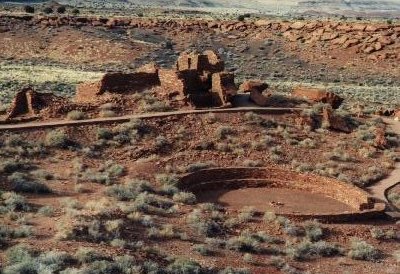
And the ancient Pueblo found time for play as well. Here is an image
of a great ball court found in several large ancient communities in the southwest.
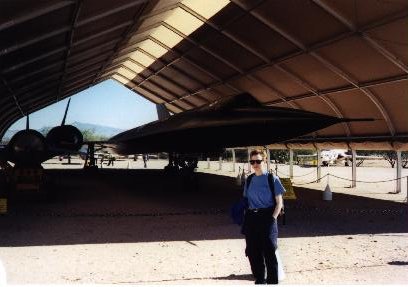
The SR-71 at the Pima County Air Museum.
Made of titanium to withstand the change in temperatures as it goes supersonic
at high altitudes. I would love a ride in it! As you can see, I am already to
fly.














